Environmental Regulation and Employment Changes in Chinese Manufacturing Enterprises: Micro Evidence from the Top 10,000 Energy-Consuming Enterprises Program
Abstract
:1. Introduction
2. Literature Review
3. Policy Background
4. Model, Variables and Data
4.1. Model and Strategy
4.2. Variables and Data
4.2.1. Core Variables
4.2.2. Data Source and Processing
5. Empirical Analysis
5.1. Analysis Based on Employment Scale
5.2. Analysis Based on Employment Structure
5.3. Robustness Test Based on Regression Discontinuity Design
6. Further Extension Analysis
6.1. Test of the Time-Varying Treatment Effect in Different Base Periods
6.2. Further Tests Using Individual Samples
6.2.1. Does Regional Institutional Variation Affect the Impact of the Carbon Reduction Policy on Enterprise Employment?
6.2.2. Does Ownership Type Affect the Impact of the Carbon Reduction Policy on Enterprise Employment?
6.2.3. Does Industry Difference Affect the Impact of the Carbon Reduction Policy on Enterprise Employment?
7. Policy Implications
8. Conclusions
Author Contributions
Funding
Institutional Review Board Statement
Informed Consent Statement
Data Availability Statement
Conflicts of Interest
References
- Porter, M.E.; Linde, C.V.D. Toward a New Conception of the Environment-Competitiveness Relationship. J. Econ. Perspect. 1995, 9, 97–118. [Google Scholar] [CrossRef]
- Gray, W.B.; Shadbegian, R.J.; Wang, C.; Meral, M. Do EPA regulations affect labor demand? Evidence from the pulp and paper industry. J. Environ. Econ. Manag. 2014, 68, 188–202. [Google Scholar] [CrossRef]
- Liu, M.; Shadbegian, R.; Zhang, B. Does environmental regulation affect labor demand in China? Evidence from the textile printing and dyeing industry. J. Environ. Econ. Manag. 2017, 86, 277–294. [Google Scholar] [CrossRef]
- Chen, Z.; Kahn, E.; Liu, Y.; Wang, Z. The Consequences of Spatially Differentiated Water Pollution Regulation in China. J. Environ. Econ. Manag. 2018, 88, 468–485. [Google Scholar] [CrossRef]
- Berman, E.; Bui, L.T. Environmental regulation and labor demand: Evidence from the south coast air basin. J. Public Econ. 2001, 79, 265–295. [Google Scholar] [CrossRef]
- Wu, X.; Cao, Y.; Xiao, Y.; Gu, J. Finding of urban rainstorm and waterlogging disasters based on microblogging data and the location-routing problem model of urban emergency logistics. Ann. Oper. Res. 2018, 290, 865–896. [Google Scholar] [CrossRef]
- Zhang, K.M.; Wen, Z.G. Review and challenges of policies of environmental protection and sustainable development in China. J. Environ. Manag. 2008, 88, 1249–1261. [Google Scholar] [CrossRef]
- Jin, Y.; Andersson, H.; Zhang, S. Air Pollution Control Policies in China: A Retrospective and Prospects. Int. J. Environ. Res. Public Health 2016, 13, 1219. [Google Scholar] [CrossRef]
- Yu, X.; Yu, X.; Lu, Y. Evaluation of an Agricultural Meteorological Disaster Based on Multiple Criterion Decision Making and Evolutionary Algorithm. Int. J. Environ. Res. Public Health 2018, 15, 612. [Google Scholar] [CrossRef]
- Alford, W.P. Law, law, what law? Mod. China 1997, 23, 398. [Google Scholar] [CrossRef]
- Deschenes, O. Climate Policy and Labor Markets; National Bureau of Economic Research, Inc.: Cambridge, MA, USA, 2010. [Google Scholar]
- Greenstone, M. The Impacts of Environmental Regulations on Industrial Activity: Evidence from the 1970 and 1977 Clean Air Act Amendments and the Census of Manufactures. J. Political Econ. 2002, 110, 1175–1219. [Google Scholar] [CrossRef]
- Walker, W.R. Environmental Regulation and Labor Reallocation: Evidence from the Clean Air Act. Am. Econ. Rev. 2011, 101, 442–447. [Google Scholar] [CrossRef]
- Kahn, M.E.; Mansur, E.T. Do local energy prices and regulation affect the geographic concentration of employment? J. Public Econ. 2013, 101, 105–114. [Google Scholar] [CrossRef]
- Bezdek, R. Environment and economy: Whats the bottom line? Environ. Sci. Policy Sustain. Dev. 1993, 35, 25–32. [Google Scholar] [CrossRef]
- Bosquet, B. Environmental tax reform: Does it work? A survey of the empirical evidence. Ecol. Econ. 2000, 34, 19–32. [Google Scholar] [CrossRef]
- Marx, A. Ecological Modernization, Environmental Policy and Employment. Can Environmental Protection and Employment be Reconciled? Innov. Eur. J. Soc. Sci. Res. 2000, 13, 311–325. [Google Scholar] [CrossRef]
- Cole, M.A.; Elliott, R.J. Do Environmental Regulations Cost Jobs? An Industry-Level Analysis of the UK. BE J. Econ. Anal. Policy 2007, 7, 1–27. [Google Scholar] [CrossRef]
- Ferris, A.E.; Shadbegian, R.J.; Wolverton, A. The Effect of Environmental Regulation on Power Sector Employment: Phase I of the Title IV SO2 Trading Program. J. Assoc. Environ. Resour. Econ. 2014, 1, 521–553. [Google Scholar] [CrossRef]
- Abrell, J.; Faye, A.N.; Zachmann, G. Assessing the Impact of the EU ETS Using Firm Level Data. Working Papers of BETA, 2011–15, Bureau d’Economie Théorique et Appliquée, UDS, Strasbourg. Available online: https://beta.u-strasbg.fr/WP/2011/2011-15.pdf (accessed on 9 August 2023).
- Ghana, H.S.; Li, S.; Zhang, F. Firm competitiveness and the European Union emissions trading scheme. Energy Policy 2013, 63, 1056–1064. [Google Scholar]
- Lu, Y. Green Policies and Jobs in China: A Double Dividend? Econ. Res. J. 2011, 46, 42–54. [Google Scholar]
- Sun, W.; Yang, Q.; Ni, Q.; Kim, Y. The impact of environmental regulation on employment: An empirical study of China’s Two Control Zone policy. Environ. Sci. Pollut. Res. Int. 2019, 26, 26472–26487. [Google Scholar] [CrossRef] [PubMed]
- Shi, M.; Wang, Y. Environmental Regulation Difference, Industry Characteristics and Employment Dynamic. South China J. Econ. 2016, 7, 48–62. [Google Scholar]
- Yuan, Y.; Xie, R. Research on the Effect of Environmental Regulation to Industrial Restructuring—Empirical Test Based on Provincial Panel Data of China. China Ind. Econ. 2014, 8, 57–69. [Google Scholar]
- Chen, C.; He, K.; Yin, X. An Empirical Research of the Impact of Environmental Regulation on Employment in China. Popul. Soc. 2014, 30, 9–14+75. [Google Scholar]
- Sun, W.; Yang, Q. The Impact of Environmental Regulation on Employment: An Empirical Study Based on TCZ Policy in China. J. Audit Econ. 2017, 32, 96–107. [Google Scholar]
- Yan, W.; Guo, S. How Does Environmental Regulation Affect Employment—An Empirical Research Based on Mediating Effect Model. Collect. Essays Financ. Econ. 2016, 10, 105–112. [Google Scholar]
- Li, M.; Du, W. The impact of environmental regulation on the employment of enterprises: An empirical analysis based on scale and structure effects. Environ. Sci. Pollut. Res. Int. 2022, 29, 21705–21716. [Google Scholar] [CrossRef]
- Zhong, S.; Xiong, Y.; Xiang, G. Environmental regulation benefits for whom? Heterogeneous effects of the intensity of the environmental regulation on employment in China. J. Environ. Manag. 2021, 281, 111877. [Google Scholar] [CrossRef]
- Sheng, J.; Zhou, W.; Zhang, S. The role of the intensity of environmental regulation and corruption in the employment of manufacturing enterprises: Evidence from China. J. Clean. Prod. 2019, 219, 244–257. [Google Scholar] [CrossRef]
- Busse, M. Trade, Environmental Regulations and the World Trade Organization: New Empirical Evidence. J. World Trade 2004, 38, 285–306. [Google Scholar] [CrossRef]
- Davis, S.J.; Haltiwanger, J. Gross Job Creation, Gross Job Destruction, and Employment Reallocation. Q. J. Econ. 1992, 107, 819–863. [Google Scholar] [CrossRef]
- Hirano, K.; Imbens, G.W. The Propensity Score with Continuous Treatments; Wiley-Blackwell: Hoboken, NJ, USA, 2004. [Google Scholar] [CrossRef]
- Liu, X.; Kang, Z. Environmental Policy and Exports in China: An Analysis Based on the Top 10,000 Energy Consuming Enterprises Program. Sustainability 2022, 14, 14157. [Google Scholar] [CrossRef]
- Groizard, J.L.; Ranjan, P.; Rodriguez-Lopez, A. Trade Costs and Job Flows: Evidence from Establishment-Level Data. Econ. Inq. 2015, 53, 173–204. [Google Scholar] [CrossRef]
- Mao, Q.; Xu, J. Input Trade Liberalization and Manufacturing Job Dynamics. Econ. Res. J. 2016, 51, 69–83. [Google Scholar]
- Grossman, G.M.; Helpman, E. Innovation and Growth in the Global Economy; MIT Press: Cambridge, MA, USA, 1993; pp. 323–324. [Google Scholar]
- Nathan, N. Relationship-Specificity, Incomplete Contracts, and the Pattern of Trade. Sch. Artic. 2007, 122, 569–600. [Google Scholar]
- Kang, Z.; Zhang, J. Impact of Institution on Independent Innovation of Domestic Manufacturing Enterprises—An Empirical Study on Chinese Domestic Enterprises. R&D Manag. 2010, 22, 103–111. [Google Scholar]
- Shen, N.; Liu, F. Can Intensive Environmental Regulation Promote Technological Innovation? Porter Hypothesis Reexamined. China Soft Sci. 2012, 4, 49–59. [Google Scholar]
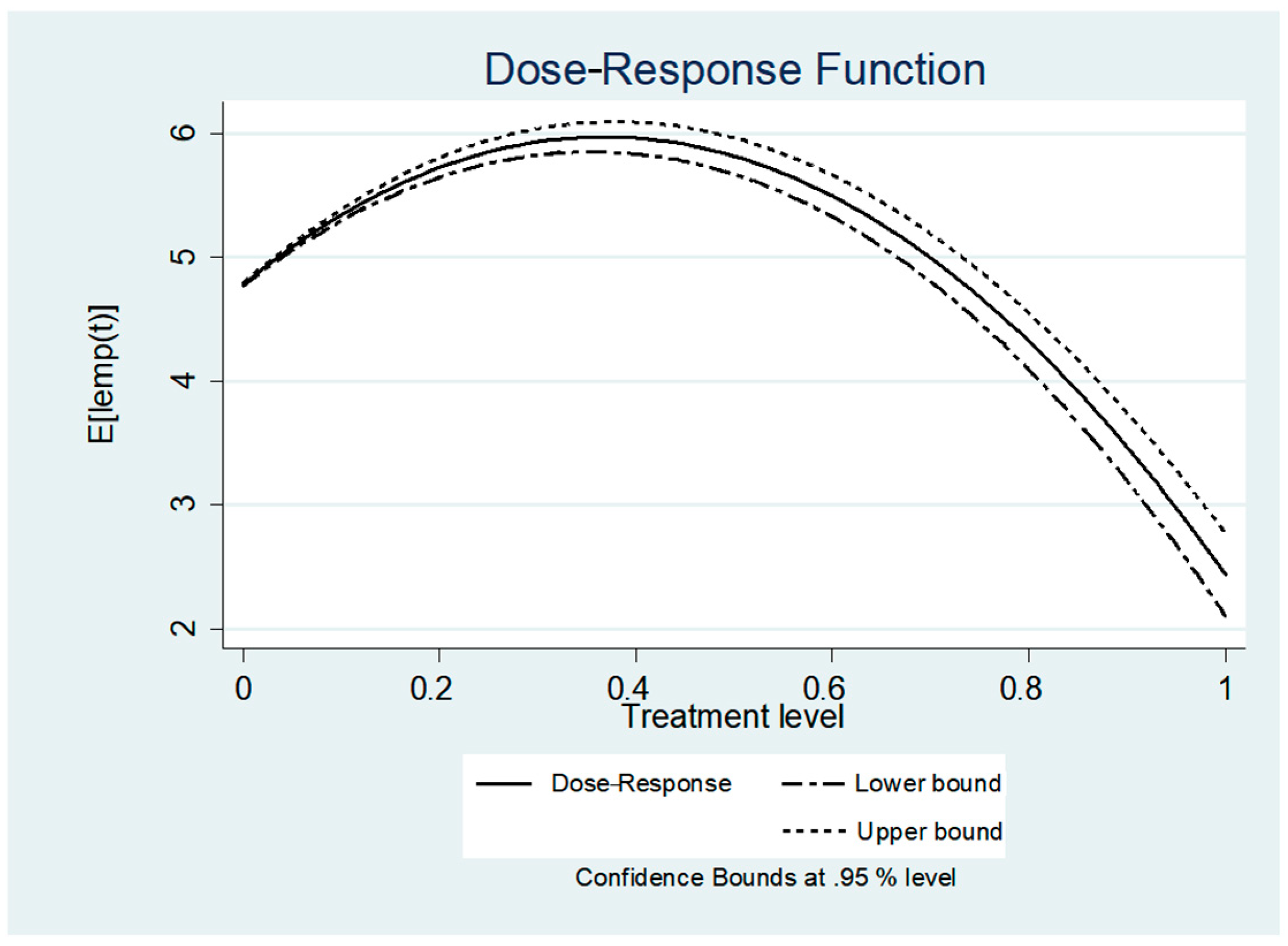
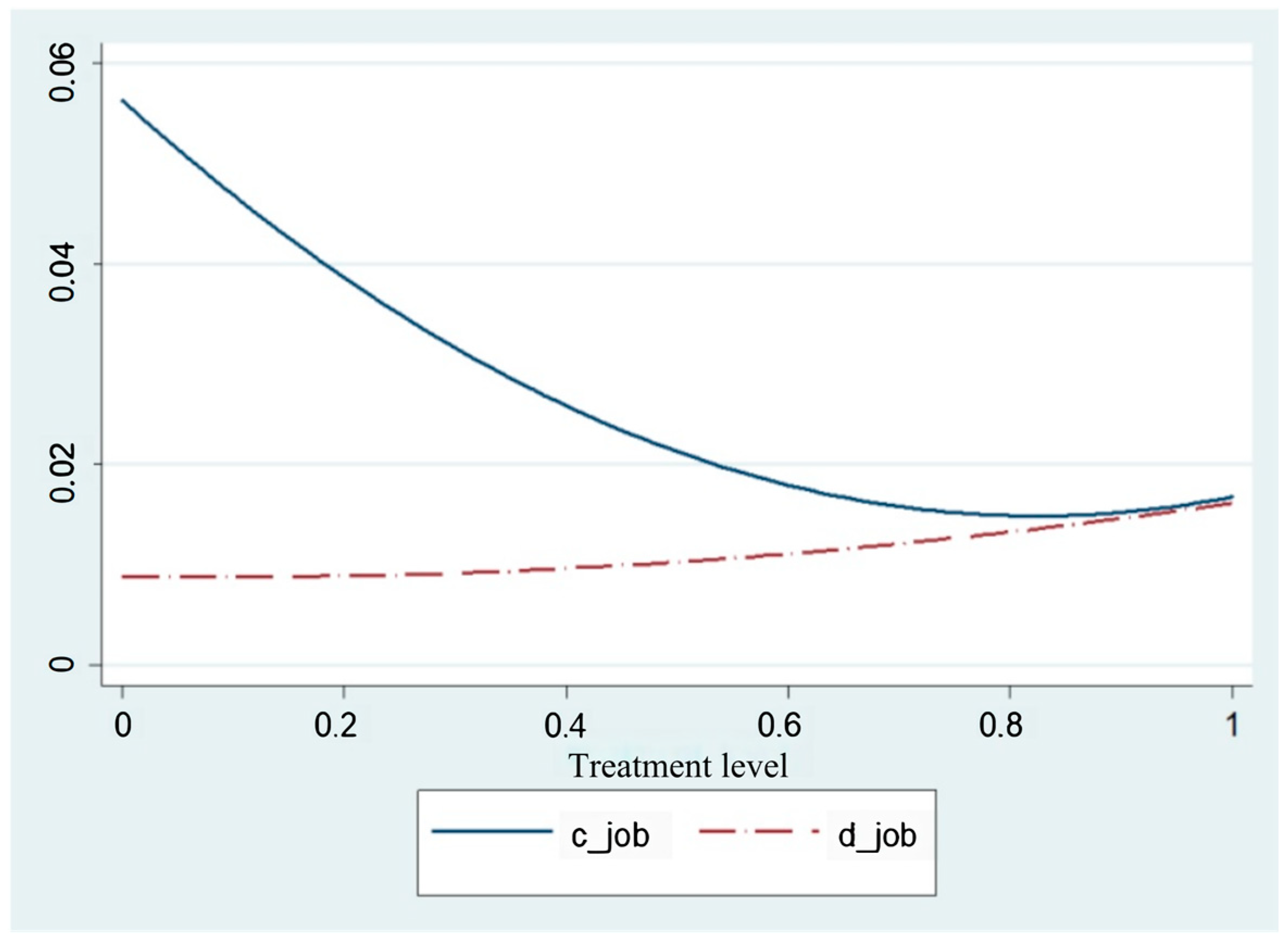
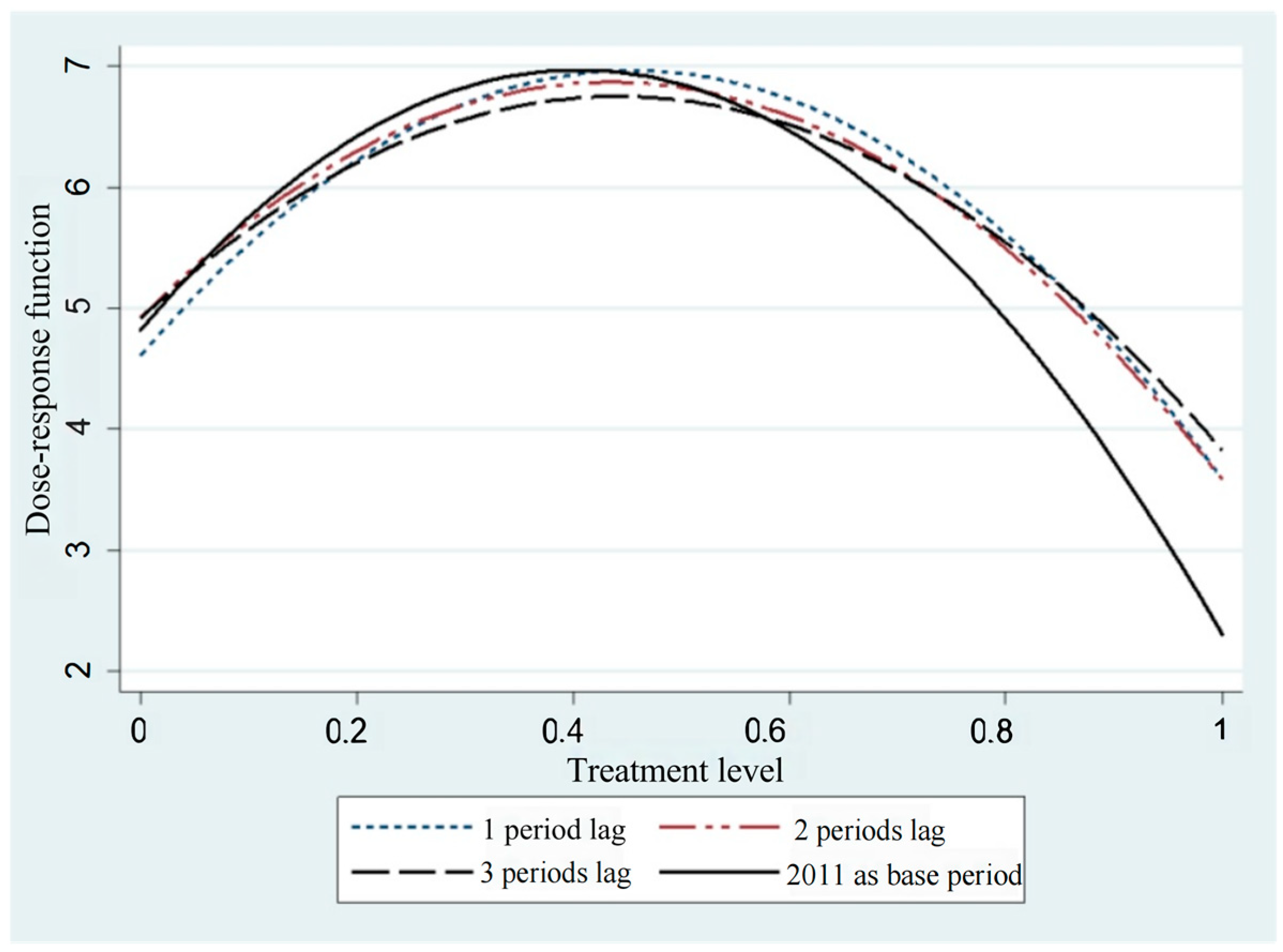
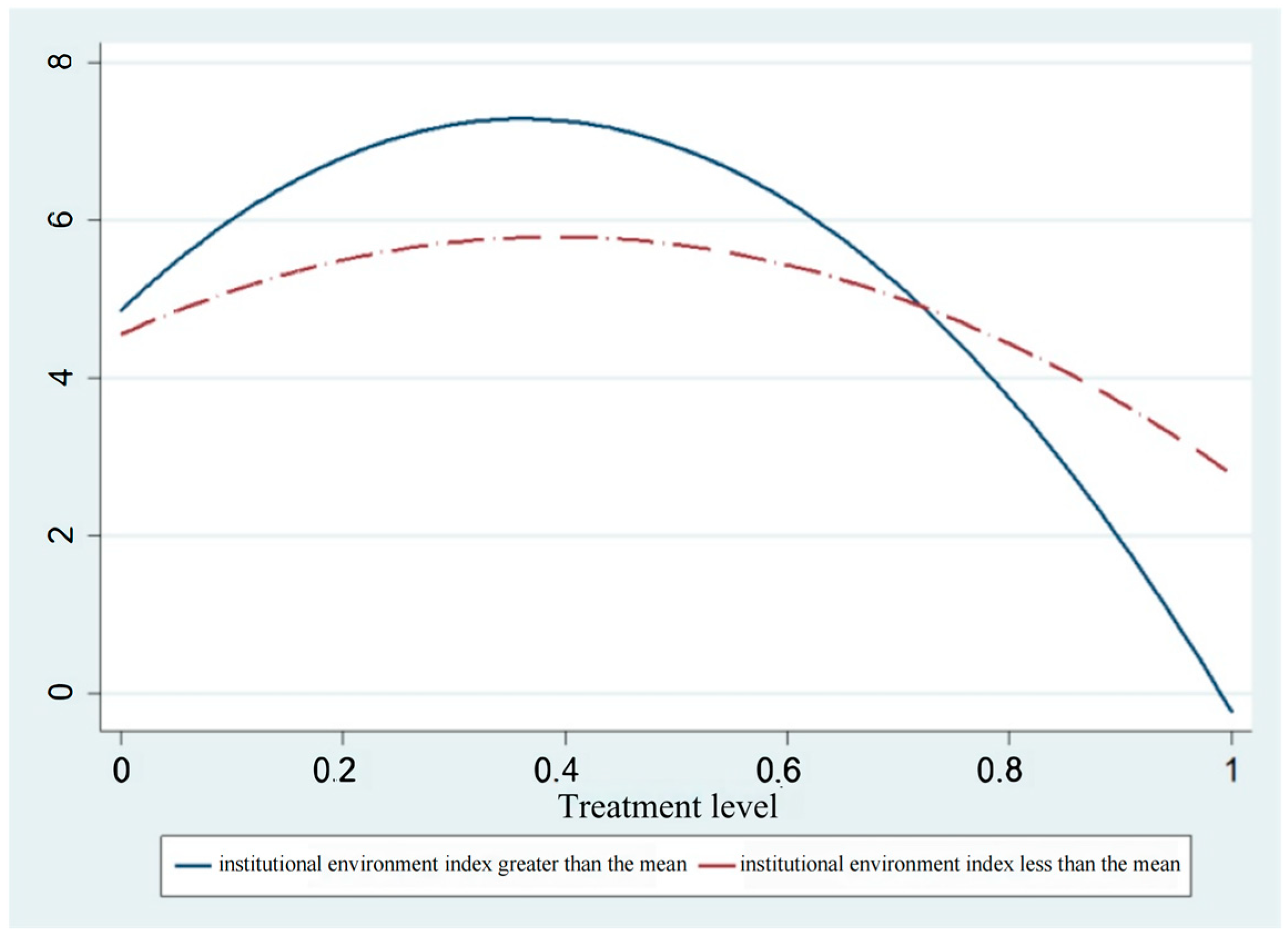

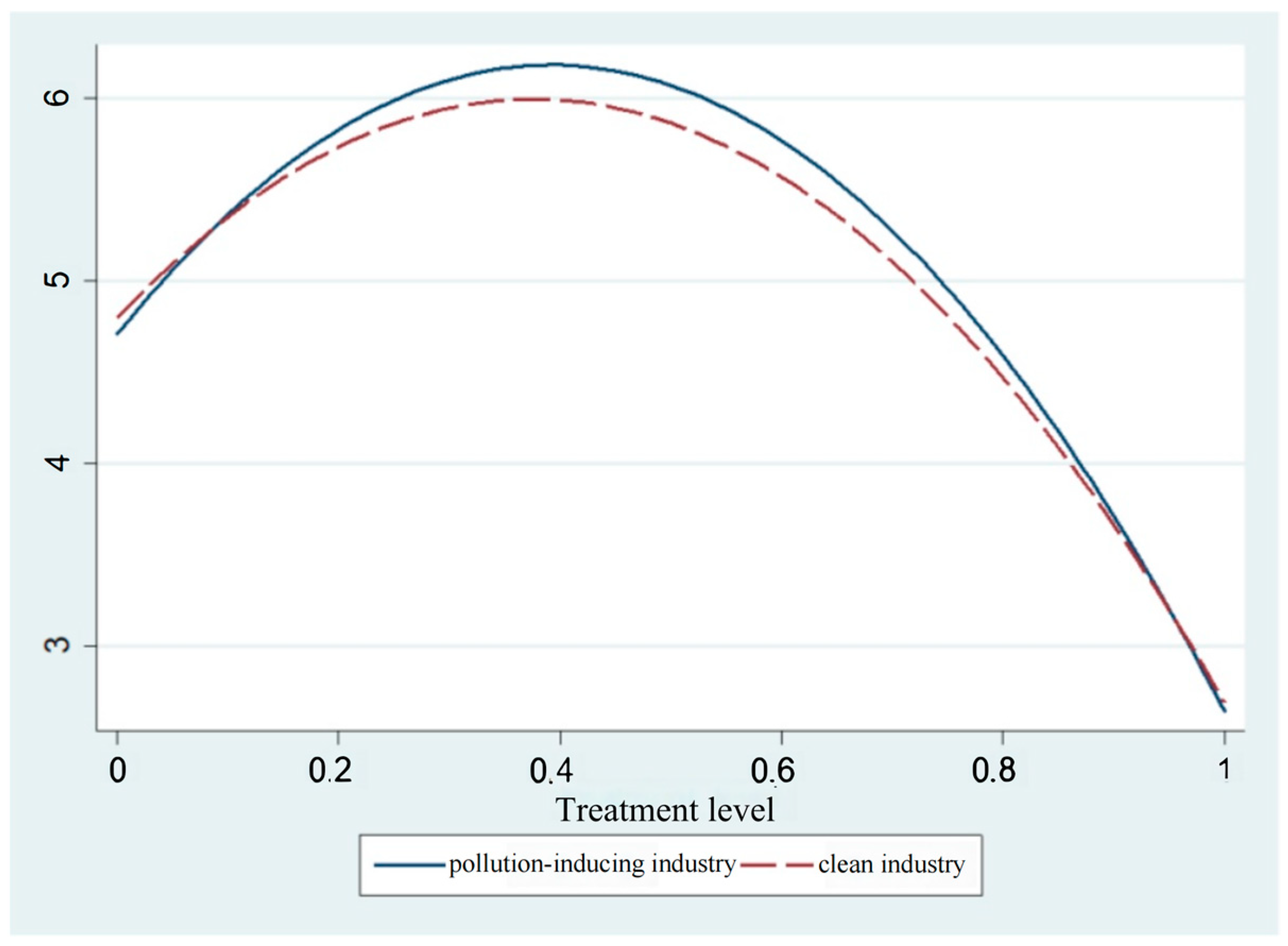
| Variable | The 10,000 Enterprises Group | Non 10,000 Enterprises Group | ||||||
|---|---|---|---|---|---|---|---|---|
| Mean | Standard Error | 25th | 75th | Mean | Standard Error | 25th | 75th | |
| Intensity of the carbon reduction policy | 0.0308 | 0.0839 | 0.0022 | 0.0248 | ||||
| Total employment | 4.0166 | 1.2565 | 3.1781 | 4.8203 | 4.8480 | 1.2831 | 3.9890 | 5.6699 |
| Employment creation | 0.0126 | 0.0988 | 0.0000 | 0.0000 | 0.0247 | 0.0730 | 0.0000 | 0.0000 |
| Employment destruction | 0.0111 | 0.0691 | 0.0000 | 0.0000 | 0.0191 | 0.1116 | 0.0000 | 0.0000 |
| Total output | 13.5515 | 1.7019 | 12.4679 | 14.6391 | 11.1704 | 1.3343 | 10.3371 | 11.9859 |
| Per capita capital | 4.6778 | 1.5065 | 3.5947 | 5.6391 | 3.2809 | 1.4086 | 2.2945 | 4.0773 |
| TFP | 7.9913 | 1.2893 | 7.1350 | 8.7796 | 6.3318 | 1.1087 | 5.5879 | 7.0245 |
| Financial condition | 0.9150 | 0.6336 | 0.5430 | 0.9245 | 0.8439 | 0.6028 | 0.4854 | 0.9277 |
| Age | 11.7005 | 13.4889 | 3.0000 | 13.0000 | 7.1545 | 7.9446 | 3.0000 | 9.0000 |
| Export in the base period | 0.6045 | 0.4890 | 0.0000 | 1.0000 | 0.4276 | 0.4947 | 0.0000 | 1.0000 |
| R&D | 0.3853 | 0.4867 | 0.0000 | 1.0000 | 0.1713 | 0.3768 | 0.0000 | 0.0000 |
| Subsidy | 2.7346 | 3.7409 | 0.0000 | 6.4785 | 0.8685 | 2.1133 | 0.0000 | 0.0000 |
| Domestic enterprises | 0.3133 | 0.4639 | 0.0000 | 1.0000 | 0.4931 | 0.4999 | 0.0000 | 1.0000 |
| The First Step | The Second Step | ||
|---|---|---|---|
| Variable | Coefficient/ Standard Error | Variable | Coefficient/ Standard Error |
| Total output | 8.72 ** | treat | 3.79793 *** |
| (2.42) | (8.20) | ||
| TFP | −3.31 *** | treat_sq | −8.82752 *** |
| (−5.18) | (−30.17) | ||
| Per capita capital | 0.00002 | gps | −187.25571 *** |
| (0.65) | (−48.16) | ||
| Financial condition | −0.00105 *** | gps_sq | 840.33732 *** |
| (−9.92) | (29.72) | ||
| Age | −0.00002 ** | treat_gps | 1242.907 *** |
| (−1.96) | (7.29) | ||
| Export | −0.00318 *** | Constant term | 5.17335 *** |
| (−7.50) | (608.17) | ||
| R&D | −0.00081 *** | ||
| (−4.02) | |||
| Subsidy | 0.00034 *** | ||
| (10.42) | |||
| Domestic enterprises | −0.00075 *** | ||
| (−5.82) | |||
| Constant term | −0.00144 *** | ||
| (−3.20) | |||
| AIC | 0.0275267 | - | |
| Industry fixed effect | Yes | - | |
| Province fixed effect | Yes | - | |
| N | 72,817 | 72,817 | |
| The likelihood function values | −2873.970407 | - | |
| Balance Condition Test | Without GPSM Adjustment | Interval Segmentation of the Carbon Reduction Policy Intensity | ||||
|---|---|---|---|---|---|---|
| [0, 0.045] | (0.045, 0.090] | (0.090, 0.143] | (0.143, 0.223] | (0.223, 1] | ||
| Total output | 1.870 *** | 0.8572 | 0.7958 | −0.1932 | 0.8965 | 0.8983 |
| (95.33) | (0.147) | (−1.533) | (−0.181) | (0.573) | (0.864) | |
| Per capita capital | 1.234 *** | 0.0078 | −0.0055 | 0.1752 | −0.0327 | −0.0882 |
| (60.14) | (0.061) | (−0.079) | (1.569) | (−0.221) | (0.841) | |
| TFP | 1.457 *** | 1.4018 *** | −0.6279 | 0.77382 | −0.4906 | 1.8979 *** |
| (85.70) | (3.342) | (−1.374) | (1.079) | (0.519) | (2.871) | |
| Age | 3.084 *** | −0.7938 | −0.5236 | 0.7349 | 0.9940 | 1.2062 ** |
| (25.53) | (−1.252) | (−1.439) | (1.272) | (1.292) | (2.2137) | |
| Export | 0.040 *** | −0.0665 | 0.0017 | −0.0038 | −0.0221 | 0.1896 |
| (6.06) | (−0.474) | (0.259) | (−0.351) | (−1.522) | (1.854) * | |
| R&D | 0.1090 *** | 0.0011 | 0.0013 | 0.0012 | 0.0014 | 0.0017 |
| (20.69) | (0.440) | (1.2543) | (0.653) | (0.714) | (1.1893) | |
| Subsidy | 1.519 *** | −1.1 | 3.8 | −3.8 | −1.4 | 5.6 |
| (47.09) | (−0.045) | (0.413) | (−0.259) | (0.710) | (0.418) | |
| Ownership | −0.139 *** | 0.0347 | 0.0455 * | 0.0373 | 0.0767 | 0.1054 *** |
| (−19.50) | (−0.783) | (1.948) | (1.03) | (1.60) | (3.110) | |
| 1 | 2 | 3 | 4 | |
|---|---|---|---|---|
| Triangular Nucleus | Rectangular Kernel | |||
| Local Wald50 | 3.64363 *** | 3.12648 *** | 4.60238 *** | 4.25298 ** |
| (3.95) | (2.97) | (3.82) | (2.38) | |
| Local Wald100 | 2.42201 *** | 1.67973 ** | 3.65797 ** | 1.04862 * |
| (2.67) | (2.42) | (2.48) | (1.82) | |
| Local Wald200 | 0.40858 | −0.21846 | 1.43088 | −0.04163 |
| (0.44) | (−0.37) | (1.21) | (−0.05) | |
| N | 1021 | 1021 | 1021 | 1021 |
Disclaimer/Publisher’s Note: The statements, opinions and data contained in all publications are solely those of the individual author(s) and contributor(s) and not of MDPI and/or the editor(s). MDPI and/or the editor(s) disclaim responsibility for any injury to people or property resulting from any ideas, methods, instructions or products referred to in the content. |
© 2023 by the authors. Licensee MDPI, Basel, Switzerland. This article is an open access article distributed under the terms and conditions of the Creative Commons Attribution (CC BY) license (https://creativecommons.org/licenses/by/4.0/).
Share and Cite
Liu, X.; Kang, Z. Environmental Regulation and Employment Changes in Chinese Manufacturing Enterprises: Micro Evidence from the Top 10,000 Energy-Consuming Enterprises Program. Sustainability 2023, 15, 13867. https://doi.org/10.3390/su151813867
Liu X, Kang Z. Environmental Regulation and Employment Changes in Chinese Manufacturing Enterprises: Micro Evidence from the Top 10,000 Energy-Consuming Enterprises Program. Sustainability. 2023; 15(18):13867. https://doi.org/10.3390/su151813867
Chicago/Turabian StyleLiu, Xin, and Zhiyong Kang. 2023. "Environmental Regulation and Employment Changes in Chinese Manufacturing Enterprises: Micro Evidence from the Top 10,000 Energy-Consuming Enterprises Program" Sustainability 15, no. 18: 13867. https://doi.org/10.3390/su151813867
APA StyleLiu, X., & Kang, Z. (2023). Environmental Regulation and Employment Changes in Chinese Manufacturing Enterprises: Micro Evidence from the Top 10,000 Energy-Consuming Enterprises Program. Sustainability, 15(18), 13867. https://doi.org/10.3390/su151813867





